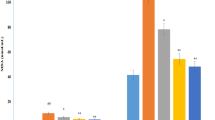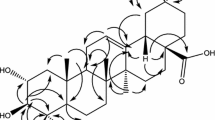Abstract
The present study was aimed to evaluate the restorative efficacy of asiatic acid (AA), an active constituent in Centella asiatica (L.) in streptozotocin (STZ)-nicotinamide (NAD)-induced diabetic rats. Male Wistar albino rats were made diabetic with STZ-NAD administration and assessed the effect of AA (20, 30, and 40 mg/kg body weight per day, for 45 days) on body weight, glucose, insulin, insulin resistance, lipid metabolic parameters in plasma and tissue (liver and kidney), and histopathology of liver in control and experimental diabetic rats. A significant (p < 0.05) increase in the concentrations of plasma and tissue lipids cholesterol, triglycerides, free fatty acids, and phospholipids and low-density and very low-density lipoproteins, and a decrease in the concentration of high-density lipoproteins were observed in diabetic rats. A significant elevation in the activity and expression of 3-hydroxy 3-methylglutaryl coenzyme A reductase in plasma and tissue and a concomitant decline in the activity of plasma lipoprotein lipase and lecithin cholesterol acyl transferase were observed in diabetic rats. The pathological abnormalities in plasma and tissues of diabetic rats were significantly ameliorated by AA supplementation for a period of 45 days and offered great support to the biochemical findings. AA also reduced the fat accumulation in the liver and protected from the hepatic steatosis. In conclusion, AA exhibited antidiabetic potential through extenuating hyperglycemic status, changing insulin resistance by alleviating metabolic dysregulation of lipid profile in both plasma and tissues.





Similar content being viewed by others
References
Bansal P, Paul P, Mudgal J, Nayak G et al (2012) Antidiabetic, antihyperlipidemic and antioxidant effects of the flavonoid rich fraction of Pilea microphylla L. in high fat diet/streptozotocin-induced diabetes in mice. Exp Toxicol Pathol 64:651–658
Brahmanaidu P, Sathibabu Uddandrao VV, Pothani S, Naik RR, Begum MS, Varatharaju C, Saravanan G (2016) Effects of S-Allylcysteine on biomarkers of the polyol pathway in rats with type 2 diabetes. Can J Diabetes 40:442–448
Brahmanaidu P, Sathibabu Uddandrao VV et al (2017) Reversal of endothelial dysfunction in aorta of streptozotocin-nicotinamide-induced type-2 diabetic rats by S-Allylcysteine. Mol Cell Biochem 432:25–32
Cho NH, Shaw JE, Karuranga S, Huang Y, Rocha Fernandes JD, Ohlrogge AW, Malanda B (2018) IDF diabetes atlas: global estimates of diabetes prevalence for 2017 and projections for 2045. Diabetes Res Clin Pract 138:271–281
Christe ME, Rodgers RL (1995) Cardiac glucose and fatty acid oxidation in the streptozotocin-induced diabetic spontaneously hypertensive rat. Hypertension 25:235–241
Dirican M, Serdar Z, Sarandol E, Gur ES (2003) Lecithin: cholesterol acyl transferase activity and cholesteryl ester transfer rate in patients with diabetes mellitus. Turk J Med Sci 33:95–101
Folch C, Lees M, Solane SGH (1957) A simple method for isolation and purification of total lipids from animal tissues. J Biol Chem 226:497–509
Hanyu O, Miida T, Obayashi K, Ikarashi T, Soda S, Kaneko S, Hirayama S, Suzuki K, Nakamura Y, Yamatani K, Aizawa Y (2004) Lipoprotein lipase (LPL) mass in preheparin serum reflects insulin sensitivity. Atherosclerosis 174:385–390
Kalaivani A, Sathibabu Uddandrao VV, Brahmanaidu P, Saravanan G, Nivedha PR, Tamilmani P, Swapna K, Vadivukkarasi S (2017) Anti obese potential of Cucurbita maxima seeds oil: effect on lipid profile and histoarchitecture in high fat diet induced obese rats. Nat Prod Res 32:2950–2953. https://doi.org/10.1080/14786419.2017.1389939
Kalaivani A, Sathibabu Uddandrao VV, Parim B et al (2018) Reversal of high fat diet-induced obesity through modulating lipid metabolic enzymes and inflammatory markers expressions in rats. Arch Physiol Biochem. https://doi.org/10.1080/13813455.2018.1452036
Meriga B, Parim B, Chunduri VR, Naik RR, Nemani H, Suresh P, Saravanan S (2017) Antiobesity potential of piperonal: promising modulation of body composition, lipid profiles and obesogenicmarker expression in HFD-induced obese rats. Nutr Metab (Lond) 14:72
Naidu PB, Uddandrao S, Naik RR, Suresh P, Meriga B, Begum MS, Saravanan G (2016) Ameliorative potential of gingerol: promising modulation of inflammatory factors and lipid marker enzymes expressions in HFD induced obesity in rats. Mol Cell Endocrinol 419:139–147
Parim B, Sathibabu Uddandrao VV, Saravanan G (2018) Diabetic cardiomyopathy: molecular mechanisms, detrimental effects of conventional treatment, and beneficial effects of natural therapy. Heart Fail Rev 24:279–299. https://doi.org/10.1007/s10741-018-9749-1
Peelman F, Vandekerckhove J, Rosseneu M (2000) Structure and function of lecithin cholesterol acyl transferase: new insights from structural predictionsand animal models. Curr Opin Lipidol 11:155–160
Pulido N, Suarez A, Casanova B, Romero R, Rodriguez E, Rovira A (1997) Gliclazide treatment of streptozotocin diabetic rats restores GLUT4 protein content and basal glucose uptake in skeletal muscle. Metabolism 46:10–13
Ramachandran V, Saravanan R, Senthilraja P (2014) Antidiabetic and antihyperlipidemic activity of asiatic acid in diabeticrats, role of HMG CoA: In vivo and in silico approaches. Phytomedicine 21:225–232
Rameshreddy P, Sathibabu Uddandrao VV, Brahmanaidu P, Saravanan G et al (2018) Obesity-alleviating potential of asiatic acid and its effects on ACC1, UCP2, and CPT1 mRNA expression in high fat diet induced obese Sprague-Dawley rats. Mol Cell Biochem 442:143–154
Salas SJ, Martinez GM, Bullo M (2011) The role of diet in the prevention of type 2 diabetes. Nutr Metab Cardiovasc Dis 21:32–48
Saravanan R, Pari L (2007) Succinic acid monoethyl ester, a novel insulinotropic agent: effect on lipid composition and lipid peroxidation in streptozotocin-nicotinamide induced type 2 diabetic rats. Mol Cell Biochem 296:165–176
Saravanan G, Ponmurugan P (2012) Ameliorative potential of S-allylcysteine: effect on lipid profile and changes in tissue fatty acid composition in experimental diabetes. Exp Toxicol Pathol 64:639–644
Saravanan G, Ponmurugan P, Senthil Kumar GP, Rajarajan T (2009) Antidiabetic properties of S-allyl cysteine, a garlic component on streptozotocin-induced diabetes in rats. J Appl Biomed 7:151–159
Saravanan G, Ponmurugan P, Machampalayam AD, Senthilkumar B (2014) Anti-obesity action of gingerol: effect on lipidprofile, insulin, leptin, amylase and lipasein male obese rats induced by a high-fat diet. J Sci Food Agric 94:2972–2977
Sathibabu U, Brahmanaidu P, Saravanan G (2017) Therapeutical perspectives of S-allylcysteine: effect on diabetes and other disorders in animal models. Cardiovasc Hematol Agents Med Chem 15:71–77
Sathibabu Uddandrao VV, Brahmanaidu P, Ravindarnaik R, Suresh P, Vadivukkarasi S, Saravanan G (2018a) Restorative potentiality of S-Allylcysteine against diabetic nephropathy through attenuation of oxidative stress and inflammation in streptozotocin-nicotinamide induced diabetic rats. Eur J Nutr. https://doi.org/10.1007/s00394-018-1795-x
Sathibabu Uddandrao VV, Brahmanaidu P, Nivedha PR, Vadivukkarasi S, Saravanan G (2018b) Beneficial role of some natural products to attenuate the diabetic cardiomyopathy through Nrf2 pathway in cell culture and animal models. Cardiovasc Toxicol 18:199–205
Sendrayaperumal V, Iyyam Pillai S, Subramanian S (2014) Design, synthesis and characterization of zinc-morin, a metal flavonol complex and evaluation of its antidiabetic potential in HFD-STZ induced type 2 diabetes in rats. Chem Biol Interact 219:9–17
Van der Wall EE (2015) Asymptomatic diabetes: screening by routine imaging beneficial? Neth Hear J 23:79–81
White MF (2003) Insulin signaling in health and disease. Science 302:1710–1711
Xie W, Wang W, Su H (2007) Hypolipidemic mechanisms of Ananas comosus L. leaves in mice: different from fibrates but similar to statins. J Pharmacol Sci 10:267–274
Author information
Authors and Affiliations
Corresponding author
Ethics declarations
Conflict of interest
The authors declare that they have no conflict of interest.
Ethical approval
The protocol of this study was approved by the institutional animal ethical committee of Muthyammal College of Arts and Science (Approval No: IAEC/MCAS/05/2017), and experiments were carried out according to the guidelines of Committee for the Purpose of Control and Supervision of Experiments on Animals (CPCSEA), Government of India.
Additional information
Publisher’s note
Springer Nature remains neutral with regard to jurisdictional claims in published maps and institutional affiliations.
Rights and permissions
About this article
Cite this article
Swapna, K., Sathibabu Uddandrao, V.V., Parim, B. et al. Effects of asiatic acid, an active constituent in Centella asiatica (L.): restorative perspectives of streptozotocin-nicotinamide induced changes on lipid profile and lipid metabolic enzymes in diabetic rats. Comp Clin Pathol 28, 1321–1329 (2019). https://doi.org/10.1007/s00580-019-02955-6
Received:
Accepted:
Published:
Issue Date:
DOI: https://doi.org/10.1007/s00580-019-02955-6




